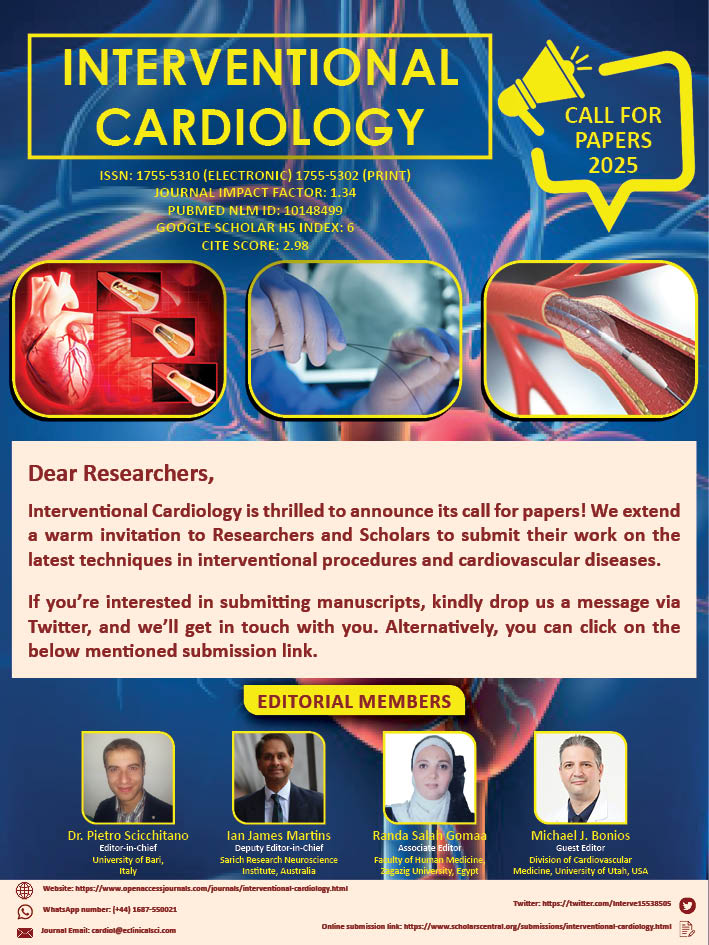Commentary - Interventional Cardiology (2024) Volume 16, Issue 5
Commentary on: A 15-year experience with total anomalous pulmonary venous connection in Vietnam
- Corresponding Author:
- Le-Thanh Q. Dinh
Department of Cardiac Surgery, Children’s Hospital 1, Ho Chi Minh, Vietnam
E-mail: dql.thanh@gmail.com
Received date: 25-Oct-2024, Manuscript No. FMIC-24-150975; Editor assigned: 28-Oct-2024, PreQC No. FMIC-24-150975 (PQ); Reviewed date: 11-Nov-2024, QC No. FMIC-24-150975; Revised date: 18-Nov-2024, Manuscript No. FMIC-24-150975 (R); Published date: 25-Nov-2024, DOI: Crossref
Description
Total Anomalous Pulmonary Venous Connection (TAPVC) represents one of the more complex forms of cyanotic congenital heart disease, necessitating prompt postnatal intervention to prevent the development of pulmonary hypertension or edema resulting from obstruction. Prognosis for untreated infants is grim, with survival rates plummeting to around 20% within the first year of life for those who do not receive timely surgical management. TAPVC is categorized using systems such as the Darling classification, which breaks it down into supra, intra, infra and mixed types. However, each of these categories encompasses a spectrum of anatomical variations that can surpass what is typically reported in clinical literature.
A meticulous understanding of these anatomical variants prior to surgery is essential, as it informs the surgical strategy, significantly reduces the duration of cardiopulmonary bypass and prepares the surgical team for unexpected challenges that may unfold during the procedure. Over our 15-year tenure in cardiac surgery, we have conducted 269 surgical interventions involving 261 cases of TAPVC and have observed a discernible increase in infra and mixed variants. While it remains true that in-hospital mortality is comparatively higher for infracardiac forms of TAPVC than for supra and intra types, it is interesting to note that despite the common perception of complexity, infra variants often present less surgical difficulty. In our approach to infra-type TAPVC, we have pioneered a Sutureless technique that modifies the traditional incision tactic used to access pulmonary veins, providing a more streamlined approach to anastomosis. On the other hand, the diversity of variants seen in supra and intracardiac TAPVC presents its own challenges, particularly for intra forms that are considered straightforward. Therefore, a thorough preoperative assessment of each patient’s unique TAPVC anatomy is crucial.
In the context of Low-and Middle-Income Countries (LMICs), where advanced imaging techniques such as Multi-Slice Computed Tomography (MSCT) or advanced echocardiographic tools may not be readily available, the necessity for intraoperative anatomical familiarity becomes even more critical. Surgeons in these settings must rely on their expertise to navigate potential anatomical variants. When MSCT can be deployed, it provides valuable insights into the patient’s specific anatomy, even when the images are of lower resolution.
Upon reviewing our findings, we noted that some intra-TAPVC cases exhibited “anatomic stenosis” without direct anastomotic connections. Echocardiographic evaluations often highlighted turbulent flows transitioning from the left pulmonary veins into the left ventricle through the mitral valve. During reoperation, it became evident that many obstructions were attributable to a membranous fold where the pulmonary veins and coronary sinus converge, particularly at the common pathway of the left pulmonary veins. Our surgical strategy included incising this membrane, extending the incision into the common pulmonary veins to facilitate better outflow.
The most intricate case we encountered was a type IId variant, characterized by the pulmonary veins merging to create common veins that led into the coronary sinus via a vertical vein. Here, simply unroofing the coronary sinus proved insufficient to ensure adequate pulmonary vein drainage into the left atrium. Instead, it necessitated extending the incision to the common veins for anastomosis directly to the left atrium, potentially utilizing autologous pericardium as a graft to optimize the connection. This experience highlighted that intracardiac TAPVC can be markedly more complex than previously assumed.
Supra cardiac TAPVC is the most common variant seen in clinical settings, showcasing the greatest range of variability. In cases where pulmonary veins on the same side merge to form a common pulmonary veins, it is critical to carefully dissect each common vein until the orifice of each pulmonary vein is fully exposed. The utility of MSCT in these scenarios cannot be overstated, as its insights into variations in vein structure and drainage pathways to the right atrium can drastically alter the surgical approach. Variations in the drainage patterns of the common veins directly into the superior vena cava add another layer of complexity that the surgical team must navigate.
Currently, our institution reports a mortality rate of approximately 20% for TAPVC surgeries, a figure that, while still above the global average, reflects a significant improvement over the past 15 years. The implementation of a Sutureless technique has particularly inspired greater confidence, enabling our team to more comprehensively address cases that historically posed significant risks, especially in low-birth-weight patients.
We recognize that while the Sutureless technique does not represent the universal standard for all TAPVC cases, it holds considerable promise for high-risk patients, including those with congenital pulmonary venous stenosis. This advancement, coupled with a thorough understanding of potential anatomical variations, equips surgeons to make informed decisions and enhance outcomes, especially in resource-limited settings where advanced diagnostics may be less accessible. By prioritizing a proactive surgical approach and maintaining vigilance during procedure execution, we aim to improve survival rates and overall quality of care for infants facing this serious congenital condition.

